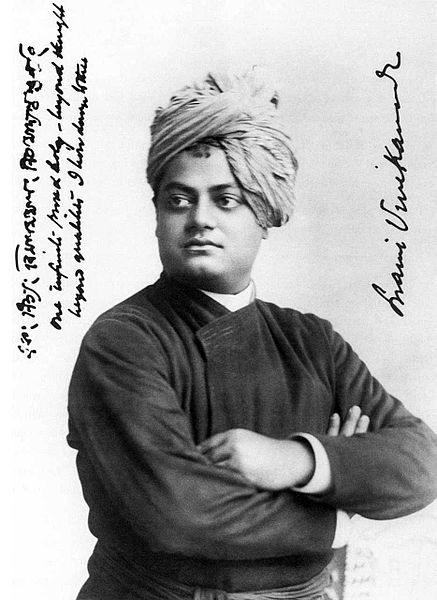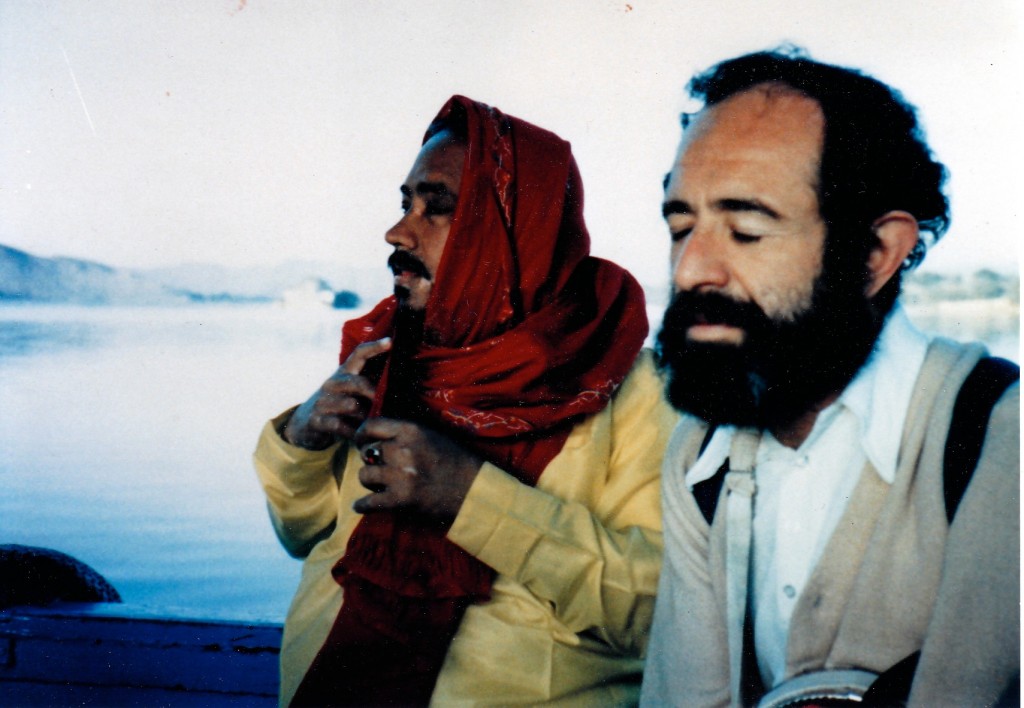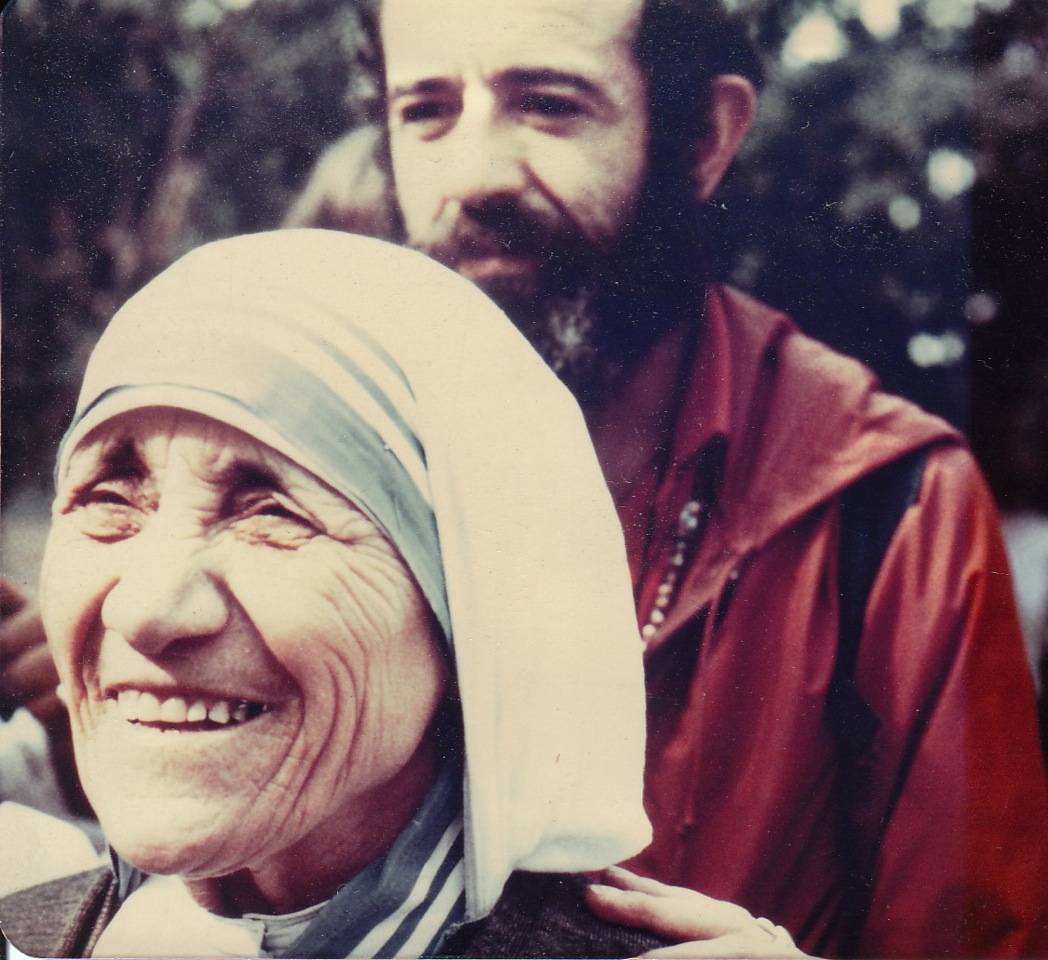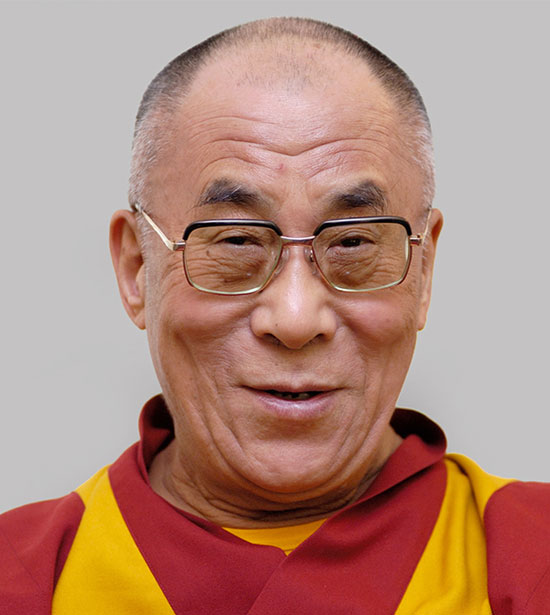Posts Tagged ‘Hinduism’
Swami Vivekananda: 15 Laws of Life
“Love Is The Law Of Life:
All love is expansion, all selfishness is contraction.
Love is therefore the only law of life.
He who loves lives, he who is selfish is dying.
Therefore, love for love’s sake,
because it is law of life, just as you breathe to live.”
~ Swami Vivekananda
“…this separation between man and man, between nation and nation,
between earth and moon, between moon and sun.
Out of this idea of separation between atom and atom comes all misery.
But the Vedanta says that this separation does not exist, it is not real.”
~ Swami Vivekananda [Jnana Yoga]
‘Time, space and causation are like the glass through which the Absolute is seen…In the Absolute there is neither time, space, nor causation.’
~ Swami Vivekananda [Jnana Yoga]
“Your own will is all that answers prayer,
only it appears under the guise
of different religious conceptions to each mind.
We may call it Buddha, Jesus, Krishna, but it is only the Self, the ‘I’.”
~ Swami Vivekananda [Jnana Yoga]
“But if there is ever to be a universal religion, it must be one which will hold no location in place or time; which will be infinite, like the God it will preach; whose Sun shines upon the followers of Krishna or Christ, saints or sinners, alike; which will not be the Brahman or Buddhist, Christian or Mohammedan, but the sum total of all these, and still have infinite space for development; which in its Catholicity will embrace in its infinite arms and find a place for every human being … It will be a religion which will have no place for persecution or intolerance in its polity, which will recognize a divinity in every man or woman, and whose whole scope, whose whole force, will be centered in aiding humanity to realize its divine nature.”
~ Swami Vivekananda

Swami Vivekananda, January 12, 1863 – July 4, 1902 *
Photo Inscription. *In September 1893 in Chicago, USA, Swami Vivekananda reverently autographed this photo with the handwritten inscription:
“One infinite pure and holy –
beyond thought beyond qualities
I bow down to thee”.
“One infinite pure and holy –
beyond thought beyond qualities
I bow down to thee”.
Introduction.
Dear Friends,
This posting honors Swami Vivekananda, the great 19th century Indian sage and orator, and founder of Western Vedanta Societies, on his 161st birthday anniversary.
As principle disciple of Holy Man Sri Ramakrishna Paramahansa, Swami Vivekananda first brought universal Indian wisdom to large Western audiences beginning as Indian delegate to the historic 1893 Chicago Parliament of World Religions, where his opening remarks famously addressed his “Sisters and Brothers of America”, and concluded with this prayerful invocation:
“I fervently hope that the bell that tolled this morning in honour of this convention may be the death-knell of all fanaticism, of all persecutions with the sword or with the pen, and of all uncharitable feelings between persons wending their way to the same goal.”
[Reenacted excerpts from his Parliament speeches are linked only online.]
Thereupon and thereafter Swami Vivekananda eloquently explained to Westerners ancient perennial principles of Hinduism, and why according to Advaita Vedanta nondualist philosophy this impermanent and ever changing world of space, time and causality is illusory; that “In the Absolute there is neither time, space nor causation”; that “Love Is The Law Of Life .. just as you breathe to live; that the goal of mankind is the knowledge [that]…oneness is the secret of everything.”
Though Vedic rishis or seers had anticipated Einstein’s 1905 theory of relativity by millennia, their teachings were largely unknown in the West until first explained by Vivekananda soon before Einstein revolutionized Western science.
Swami Vivekananda experientially had realized as impermanent and illusory the appearance of our space, time, causality, and duality reality. From his rare level of nondualist consciousness beyond ego-mind he shared many wise perennial teachings to guide our lives on Earth, including the “Fifteen Laws of Life”, which follow, with my explanatory comments.
Written over a hundred years ago, these fundamental wisdom teachings remain exceptionally important for our worldwide transcendent awakening opportunities in current times.
May they deeply inspire and guide us to help heal the World by realizing and experiencing their fundamental truths.
Swami Vivekananda: 15 Laws of Life.
1. Love Is The Law Of Life: All love is expansion, all selfishness is contraction. Love is therefore the only law of life. He who loves lives, he who is selfish is dying. Therefore, love for love’s sake, because it is law of life, just as you breathe to live.
2. It’s Your Outlook That Matters: It is our own mental attitude, which makes the world what it is for us. Our thoughts make things beautiful; our thoughts make things ugly. The whole world is in our own minds. Learn to see things in the proper light.
3. Life is Beautiful: First, believe in this world – that there is meaning behind everything. Everything in the world is good, is holy and beautiful. If you see something evil, think that you do not understand it in the right light. Throw the burden on yourselves!
4. It’s The Way You Feel: Feel like Christ and you will be a Christ; feel like Buddha and you will be a Buddha. It is feeling that is the life, the strength, the vitality, without which no amount of intellectual activity can reach God.
5. Set Yourself Free: The moment I have realised God sitting in the temple of every human body, the moment I stand in reverence before every human being and see God in him – that moment I am free from bondage, everything that binds vanishes, and I am free.
6. Don’t Play The Blame Game: Condemn none: if you can stretch out a helping hand, do so. If you cannot, fold your hands, bless your brothers, and let them go their own way.
7. Help Others: If money helps a man to do good to others, it is of some value; but if not, it is simply a mass of evil, and the sooner it is got rid of, the better.
8. Uphold Your Ideals: Our duty is to encourage every one in his struggle to live up to his own highest idea, and strive at the same time to make the ideal as near as possible to the Truth.
9. Listen To Your Soul: You have to grow from the inside out. None can teach you, none can make you spiritual. There is no other teacher but your own soul.
10. Be Yourself: The greatest religion is to be true to your own nature. Have faith in yourselves!
11. Nothing Is Impossible: Never think there is anything impossible for the soul. It is the greatest heresy to think so. If there is sin, this is the only sin – to say that you are weak, or others are weak.
12. You Have The Power: All the powers in the universe are already ours. It is we who have put our hands before our eyes and cry that it is dark.
13. Learn Everyday: The goal of mankind is knowledge… now this knowledge is inherent in man. No knowledge comes from outside: it is all inside. What we say a man ‘knows’, should, in strict psychological language, be what he ‘discovers’ or ‘unveils’; what man ‘learns’ is really what he discovers by taking the cover off his own soul, which is a mine of infinite knowledge.
14. Be Truthful: Everything can be sacrificed for truth, but truth cannot be sacrificed for anything.
15. Think Different: All differences in this world are of degree, and not of kind, because oneness is the secret of everything.
Ron’s Explanation.
Swami Vivekananda had realized and revealed to us that this ego-mind illusory 3D “reality” of supposed space, time, and causality-duality, is an unavoidable mere mental mirage beyond human thought comprehension, imagination, or expression.
Like Jesus Christ and countless other prior and subsequent spiritual avatars and seers, Vivekananda proclaimed (in 20th century vernacular) the pre-primordial non-dualist truth that “Love Is The Law of Life”, that the infinitely powerful and potential Human Heart and the Cosmos are not separated, but One Eternal LOVE.
For example, two thousand years ago Jesus Christ incarnated in a mortal human body to reveal that: “I and the Father are ONE”, and that “God is Love” saying:
“Let us love one another: for love is of God;
and everyone that loves is born of God, and knows God.
He that loves not, knows not God; for God is love.
If we love one another, God dwells in us, and His
love is perfected in us.” [1 John 4:7-8; 12 ]”
Jesus taught us to not only love each other, but to love and forgive even our enemies, importuning God while suffering excruciating pain as He was being crucified by Roman soldiers,
“Father, forgive them; for they know not what they do.”
~ Luke 23:34
Jesus so demonstrated that because we not separated but exist as One Eternal LOVE when we love each other we love our Eternal SELF – our Divine Mother/Father Creator and Sole Source.
Thus, Swami Vivekananda revealed over a hundred years ago, that these same fundamental wisdom teachings of Jesus, remain exceptionally important for our worldwide transcendent awakenings in current times.
And such revelations can inspire and awaken a pivotal “critical mass” turning point in human history, when much of humankind will energetically awaken to loving levels of consciousness and spiritual freedom.
We are thereby immensely blessed to participate in thus raising humanity’s collective consciousness, as we gratefully awaken from inside out as ONE INFINITELY POTENTIAL Divine LOVE .
Ron’s Dedication.
This posting honors both Swami Vivekananda and his renowned Spiritual Master, Sri Ramakrishna Paramahansa, whose lives and teachings have been extraordinarily inspirational for countess beings, including me. Additionally it honors my beloved Guruji, Shri Dhyanyogi Madhusudandas, who was also inspired by Vivekananda.
Vivekananda considered Shri Ramakrishna as “higher and nobler than all ordinary” teachers, and attributed all his powers to Ramakrishna, saying:
“All that I am . . is owing to my Master, Shri Ramakrishna, who incarnated and experienced and taught this wonderful unity which underlies everything, having discovered it alike in Hinduism, in Islam, and in Christianity.” [His] “One touch, one glance, can change a whole life.”
Synchronistically, my Guruji Shri Dhyanyogi – who was another one of those rare great beings whose “One touch, one glance, can change a whole life.” – was crucially inspired and helped by Vivekananda.
The fascinating story of how this happened is told in “This House is on Fire, The Life of Shri Dyanyogi”, pp 61-64, by Shri Anandi Ma.
After fifteen years of solitary wandering in rural India Guruji had a dramatically transformative vision of Vivekanda, who assured Guruji that he would reach his spiritual goal.
Soon thereafter Guruji discovered and was enthralled by Vivekananda’s teachings published in the book Raja Yoga, which included his apt lectures in the West, and commentaries explaining Patanjali’s Yoga Sutras, widely accepted as a foundational Sanskrit text of Raja Yoga philosophy.
Guruji continuously read and re-read Vivekandanda’s Raja Yoga book, like a scripture, and ultimately he repeatedly recommended it to his disciples, including me.
Invocation.
May these precious wisdom teachings continue to inspire and guide countless people worldwide in current critical times.
And so may it be!
Ron Rattner
Reenacted audio excerpts from Vivekananda talks at 1893 Chicago Parliament of World Religions.
Close Out Your ‘Karma Card’ Accounts
“Karma is a cosmic incentive system.”
~ Ron Rattner, Sutra Sayings
“The Book of Life is a karmic comic book.”
~ Ron Rattner, Sutra Sayings
“Every action, every thought, reaps its own corresponding rewards. Human suffering is not a sign of God’s, or Nature’s, anger with mankind. It is a sign, rather, of man’s ignorance of divine law. . . .
Such is the law of karma: As you sow, so shall you reap. If you sow evil, you will reap evil in the form of suffering. And if you sow goodness, you will reap goodness in the form of inner joy.”
~ Paramhansa Yogananda
“It is true that we are not bound. That is to say, the real Self has no bondage. And it is true that you will eventually return to your Source. But meanwhile, if you commit sins, as you call them, you have to face the consequences. You cannot escape them.”
~ Ramana Maharshi
“Clear your past, to live as presence.
Clear your karma, to live your dharma.”
~ Ron Rattner, Sutra Sayings
“To go from mortal to Buddha, you have to put an end to karma,
nurture your awareness, and accept what life brings.”
~ Bodhidharma

Introduction
Dear Friends,
We are living in difficult times, with many people enduring much suffering.
In such hard times, laughter and levity always help. Also, truth said in jest can help us understand and remember previously unknown ways to transcend suffering.
So the following “Close Out Your ‘Karma Card’ Accounts” whimsical sutra-poem is about suffering from karma, a spiritually significant subject that many people don’t yet consider or comprehend.
As hereafter explained, it is dedicated to helping us transcend inevitable cause and effect suffering from the earthly illusion of duality.
And so may it be,
Ron Rattner
Close Out Your ‘Karma Card’ Accounts
Coming from subtle planes to Earth
(the plane of space/time and causation)
the soul dons an “earth suit” – a human body/mind –
as its vehicle to explore this realm.
Each such vehicle comes equipped with
a revolving “karma card” account.
The object of the visit is to clear all “karma card” debits,
without incurring new ones.
Until we close out all our “karma card” accounts,
our visits to Earth become endless revolving round trips
repeated in a different vehicle for each trip.
So, we’re here to try closing out
all our “karma card” accounts.
Ron’s Karmic Commentary:
Dear Friends,
Karma is the subtle spiritual manifestation of Newton’s Third Law of Motion, that for every physical action there is an equal and opposite reaction. It is a natural tendency which governs all space/time interactions including those on on subtle or spiritual planes, where we ‘reap as we sow’.
Thus, for every space/time thought, word or deed – there is also an equivalent and opposite reaction on subtle or spiritual planes. So karma can be seen as “a cosmic incentive system”, of cause and effect.
As explained by Paramhansa Yogananda: “Every action, every thought, reaps its own corresponding rewards” – either joy or suffering.
Hence, knowing the law of karma can encourage us to do good and be good – even if initially we are motivated by what the Dalai Lama has called ‘enlightened selfishness’. Yogis say that by selflessly doing good we can transcend inevitable suffering from identification with this physical world, which they see as unreal illusion – maya or samsara.
But, as Swami Yogananda observed, “those who cling to the cosmic illusion must accept its essential law of polarity: flow and ebb, rise and fall, day and night, pleasure and pain, good and evil, birth and death.”
So to help us transcend suffering from the illusion of polarity, I sincerely invite your mindful consideration of the foregoing whimsical sutra-poem verses about karma.
May they help us sow ever more loving-kindness and compassion, bringing everyone everywhere ever more worldly happiness and fulfillment, until ultimately we reap eternal joy.
And so shall it be!
Ron Rattner
Ron’s audio explanation and recitation of Close Out Your ‘Karma Card’ Accounts
Synchronicity Story: Miraculously Manifesting Memories of a Spiritual Pilgrimage to India and Nepal
“Synchronicity is choreographed by a great, pervasive intelligence that lies at the heart of nature,
and is manifest in each of us through what we call the soul.”
~ Deepak Chopra, Spontaneous Fulfillment of Desire
“There are only two ways to live your life.
One is as though nothing is a miracle.
The other is as though everything is a miracle.”
~ Albert Einstein

Ron Meditating On Ganges With Sant Keshadavadas, 1982
Ron’s Introduction
As explained in other posts, during a traumatic 1976 divorce, I experienced a transformative mid-life spiritual awakening. Two years later, I met a hundred year old Hindu guru, Shri Dhyanyogi Madhusudandas, and evolved from being a secular Hebrew, to becoming a “born-again Hindu”. Then gradually I developed ever increasing interest and curiosity about Indian spirituality and culture. After a few years, the “universe” presented me with an ideal opportunity to satisfy that curiosity.
In 1981, soon after my beloved Guruji, Dhyanyogi, had returned to India, I met Sant Keshadavadas, a devotional Indian spiritual teacher known as a singing saint. Especially in the absence of Guruji, I appreciated Sant Keshadavadas’ loving demeanor, singing, stories and teachings. So I frequently attended programs at his Oakland, California “Temple of Cosmic Religion”. Thereafter, on learning that Sant Keshadavadas would be conducting a spiritual tour of Indian holy places, I wanted to join that tour.
So after obtaining Guruji’s approval, in January and February 1982, I journeyed with Sant Keshadavadas on a wonderful spiritual pilgrimage to Japan, India and Nepal. That guided tour was, and remains for me, the most important trip of my lifetime.
Never before had I been in a land with such a palpably spiritual ambiance as I experienced everywhere in India. Our tour group crossed the length and breadth of that vast country (mostly by airplane and local buses) visiting many spiritual shrines and meeting saintly beings, like Mother Teresa and Satya Sai Baba. And I had numerous wondrous experiences. (In other chapters I have recounted some of those experiences.)

Ron with Mother Teresa, Calcutta, 1982

Sai Baba blessing Ron, Bangalore, 1982
Ten years after that trip, in 1992 I retired from law practice and returned to India to pay my respects to Guruji, who at age 114 requested that I write and publish my spiritual memoirs. Though initially bewildered by this request, I knew that such memoirs needed to describe experiences during my 1982 ‘trip of a lifetime’. But I hadn’t kept a diary during that pilgrimage trip, and had to rely mostly on memory to tell about it.
Thereafter, many years passed during which I lived in introspective semi-seclusion, without a TV, computer, newspaper, or radio news of the “real world”, meditating, praying, seeking philosophical answers to ultimate questions, and “enlightenment”. During these years I did not yet feel ready to honor Guruji’s request that I write and publish my spiritual memoirs. But I was always mindful of the importance of fulfilling his wishes.
More than twenty years after my ‘trip of a lifetime’, while thinking about Guruji’s request, I discussed it with two long-time spiritual friends. I told them that while I was delaying in writing and publishing my spiritual memoirs they were being edited by time, as my memories waned. And I expressed concern about whether I could remember sufficient details of the 1982 pilgrimage to India, suggesting that my friends might be able to help me remember stories I had previously shared with them.
Thereafter, within a couple of weeks, the universe produced an amazing double synchronicity – two “manifestation miracles” which re-kindled memories of that momentous trip.
Synchronicity story
Here is what happened:
One afternoon while walking to the Marina Green adjoining San Francisco Bay I intended picking some dandelion and fennel leaves for my salad. But as I passed across the street from the Marina Safeway supermarket, I realized that I’d forgotten to bring a plastic bag in which to carry my ‘harvest’. After momentarily considering a detour into the Safeway, I decided instead to keep my eyes peeled for stray small bags which then commonly could be seen blowing around in the public park area where I was walking.
Soon I saw at a distance on the sidewalk ahead of me a white plastic bag, and presumed that it was just what I needed. But as I approached it, I saw that it was far too large for my purposes – a Bed & Bath bag rather than a Safeway bag. So, rather than leaving it cluttering the sidewalk where it might be blown into the water, I decided to put the plastic bag into a nearby waste dumpster.
I picked up the bag, walked a few a yards to the dumpster, and opened the dumpster lid prepared to discard the bag. But I was diverted by a surprising sight. Clearly visible, at the very top of the refuse pile in the dumpster, were about a dozen commercial VHS video tapes, which I began to examine with curiosity. If I’d come sooner, the tapes probably wouldn’t yet have been discarded; if I came later they’d probably already be covered over with much more trash, and not be visible.
As I looked at the video titles, I saw that they all seemed related to spiritual subjects that interested me, like yoga. Though never before a ‘dumpster diver’, I decided that I’d like to take all those videos home and check them out.
Thereupon, I wondered momentarily how I could carry them. Then, remembering the large plastic bag that had led me to the dumpster, I laughed as I realized that the universe had not only led me to the videos, when they were clearly visible, but also had provided me a bag perfectly sized to carry them home. So I put them in that bag, which when loaded became quite heavy.
So, unable to continue walking as planned, I returned home with the heavy bag of videos but without dandelion or fennel for my salad. At home I discovered to my amazement that the universe had just produced perhaps the most extraordinary “manifestation miracles” of my life.
On examining the videos, I found one titled “Call of the Flute – Spiritual Journey To India And Nepal”*. To my delight and amazement, I discovered that it was all about my 1982 pilgrimage to India with Sant Keshavadas.
And then I remembered that a team of professional videographers, led by a devotee of Sant Keshavadas, David Karp, had accompanied our tour group. Apparently afterwards they had produced and distributed this one hour documentary video for display on some non-network and cable television outlets. I had never acquired a copy of the video, and don’t recall ever before seeing it.
Yet somehow, over twenty years later, a copy of that video had synchronistically manifested for me in a Marina garbage dumpster which I unexpectedly visited at a rare time when videos were visible at the top of the garbage pile, and when I had just found a plastic bag large enough to carry them home.
And on viewing the video at home I found that it included numerous scenes which had been filmed when I was present, thus serendipitously rekindling memories of that momentous trip, and fulfilling my recently expressed desire for such reminders.
Concluding thoughts
Who can explain such synchronicity “miracles”? Nonetheless, despite their mysterious origins, such synchronicities can fill us with feelings of awe and gratitude for our miraculous life on this precious planet, and remind us that we are part of Nature, connected and interdependent with all Life everywhere.
Einstein once observed that: “Coincidence is God’s way of remaining anonymous.” As I have been ever more blessed by such noteworthy and amazing “coincidences”, they ever more inspire and infuse me with heartfelt gratitude for the grace of this lucky life, and for the omnipresent but ‘anonymous’ Divine Source – The Lone Arranger – of all appearances therein.
*Videographer David Karp has generously permitted me to share with you on You Tube this documentary video, which so miraculously manifested for me just when I was trying to recall details of our 1982 pilgrimage to India and Nepal.
Dalai Lama – Many Faiths, One Truth

Many Faiths, One Truth
By Tenzin Gyatso
WHEN I was a boy in Tibet, I felt that my own Buddhist religion must be the best — and that other faiths were somehow inferior. Now I see how naïve I was, and how dangerous the extremes of religious intolerance can be today.
Though intolerance may be as old as religion itself, we still see vigorous signs of its virulence. In Europe, there are intense debates about newcomers wearing veils or wanting to erect minarets and episodes of violence against Muslim immigrants. Radical atheists issue blanket condemnations of those who hold to religious beliefs. In the Middle East, the flames of war are fanned by hatred of those who adhere to a different faith.
Such tensions are likely to increase as the world becomes more interconnected and cultures, peoples and religions become ever more entwined. The pressure this creates tests more than our tolerance — it demands that we promote peaceful coexistence and understanding across boundaries.
Granted, every religion has a sense of exclusivity as part of its core identity. Even so, I believe there is genuine potential for mutual understanding. While preserving faith toward one’s own tradition, one can respect, admire and appreciate other traditions.
An early eye-opener for me was my meeting with the Trappist monk Thomas Merton in India shortly before his untimely death in 1968. Merton told me he could be perfectly faithful to Christianity, yet learn in depth from other religions like Buddhism. The same is true for me as an ardent Buddhist learning from the world’s other great religions.
A main point in my discussion with Merton was how central compassion was to the message of both Christianity and Buddhism. In my readings of the New Testament, I find myself inspired by Jesus’ acts of compassion. His miracle of the loaves and fishes, his healing and his teaching are all motivated by the desire to relieve suffering.
I’m a firm believer in the power of personal contact to bridge differences, so I’ve long been drawn to dialogues with people of other religious outlooks. The focus on compassion that Merton and I observed in our two religions strikes me as a strong unifying thread among all the major faiths. And these days we need to highlight what unifies us.
Take Judaism, for instance. I first visited a synagogue in Cochin, India, in 1965, and have met with many rabbis over the years. I remember vividly the rabbi in the Netherlands who told me about the Holocaust with such intensity that we were both in tears. And I’ve learned how the Talmud and the Bible repeat the theme of compassion, as in the passage in Leviticus that admonishes, “Love your neighbor as yourself.”
In my many encounters with Hindu scholars in India, I’ve come to see the centrality of selfless compassion in Hinduism too — as expressed, for instance, in the Bhagavad Gita, which praises those who “delight in the welfare of all beings.” I’m moved by the ways this value has been expressed in the life of great beings like Mahatma Gandhi, or the lesser-known Baba Amte, who founded a leper colony not far from a Tibetan settlement in Maharashtra State in India. There he fed and sheltered lepers who were otherwise shunned. When I received my Nobel Peace Prize, I made a donation to his colony.
Compassion is equally important in Islam — and recognizing that has become crucial in the years since Sept. 11, especially in answering those who paint Islam as a militant faith. On the first anniversary of 9/11, I spoke at the National Cathedral in Washington, pleading that we not blindly follow the lead of some in the news media and let the violent acts of a few individuals define an entire religion.
Let me tell you about the Islam I know. Tibet has had an Islamic community for around 400 years, although my richest contacts with Islam have been in India, which has the world’s second-largest Muslim population. An imam in Ladakh once told me that a true Muslim should love and respect all of Allah’s creatures. And in my understanding, Islam enshrines compassion as a core spiritual principle, reflected in the very name of God, the “Compassionate and Merciful,” that appears at the beginning of virtually each chapter of the Koran.
Finding common ground among faiths can help us bridge needless divides at a time when unified action is more crucial than ever. As a species, we must embrace the oneness of humanity as we face global issues like pandemics, economic crises and ecological disaster. At that scale, our response must be as one.
Harmony among the major faiths has become an essential ingredient of peaceful coexistence in our world. From this perspective, mutual understanding among these traditions is not merely the business of religious believers — it matters for the welfare of humanity as a whole.
Tenzin Gyatso, the 14th Dalai Lama, is the author, most recently, of “Toward a True Kinship of Faiths: How the World’s Religions Can Come Together.”
Originally published as an Op-Ed by New York Times on May 24, 2010
